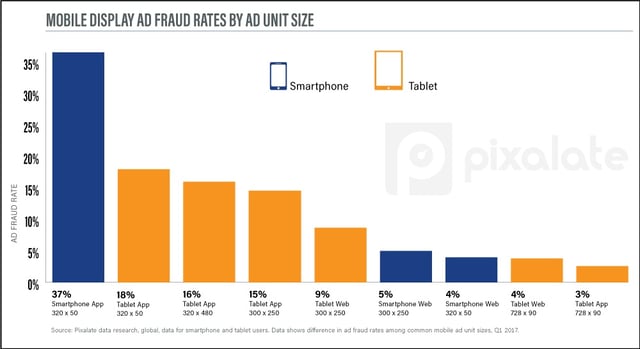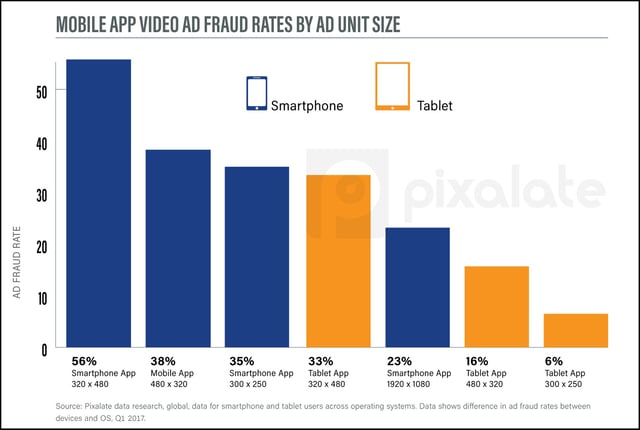Our run through Q1 2017 programmatic ad fraud rates has zeroed in on mobile trends over the past week, and we’re continuing the in-depth mobile analysis today with a look at mobile ad fraud rates for some of the most common ad unit sizes both in-app and on the web across smartphones and tablets.
37% of 320x50 ad units are fraudulent within smartphone apps
- The IAB standard 320x50 mobile leaderboard is fraudulent within smartphone apps over one-third of the time, at 36.6%.
- The 320x50 smartphone app ad unit has a fraud rate over 2x higher than any of the other most popular display ad units on mobile devices.
- The 320x50 unit is popular among fraudsters on tablet apps as well, with an 18% fraud rate. The 320x480 and 300x250 tablet app units are next, with Q1 2017 fraud rates of 16% and 14.6%, respectively.
Our previous blog post noted that smartphone app ads are fraudulent more often than smartphone web ads, so it’s not surprising to see this trend ring true when looking at specific ad unit sizes as well.
However — in contrast to the above statement — our previous findings also noted that, overall, tablet app and web ads are fraudulent at roughly the same rate (12%). But when breaking it down by specific ad units, we see that common tablet app ad unit sizes are utilized most often by fraudsters.
This contrast highlights the nuanced differences between tablets and smartphones as two distinct devices in the mobile ecosystem
Mobile app video: 320x480 unit fraudulent 56% of the time on smartphones

- The 320x480 smartphone app ad unit — a standard interstitial video ad unit — was fraudulent over half (55.8%) of the time in Q1 2017
- Similarly, the 480x320 smartphone video app unit was fraudulent 38.3% of the time.
- The 300x250 smartphone (35%) and 320x480 tablet (33.4%) ad units were both fraudulent over one-third of the time in Q1 2017.
Video ad fraud rates are typically higher than display ad fraud rates on mobile devices in general, and this is readily apparent when we look at the individual ad units most commonly affected by ad fraud. Four of the most common mobile video app ad unit sizes (320x480, 480x320, and 300x250 for smartphones, and 320x480 for tablets) are fraudulent over one-third of the time.
Download the list of mobile app platforms with the best inventory quality in March.

This post is part of an ongoing series highlighting Pixalate's Quarterly Global Ad Fraud Benchmarks for Q1 2017. Sign up for our blog to learn more.









